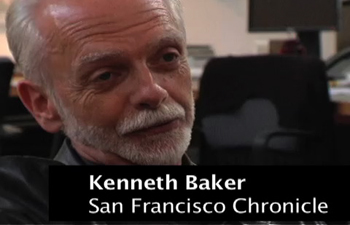5Across is sponsored by Carnegie-Knight News21, an alliance of 12 journalism schools in which top students tell complex stories in inventive ways. See tips for spurring innovation and digital learning at Learn.News21.com.
As newspapers and magazines have cut staff in the shift to digital, arts critics find themselves with less sure footing when it comes to a full-time staff position. According to a recent article in the Australian, 65 full-time film critics have lost jobs on American newspapers and magazines since 2006. Can’t local newspapers just use syndicated reviews for movies shown nationally? And isn’t the Internet giving many more critics outside of traditional publications the chance to shine?
Plus, there are review aggregator sites such as Rotten Tomatoes and Metacritic that simply give people a roundup of what critics have said about a particular movie. In the case of Rotten Tomatoes, you even get a 1 to 100 rating that is an aggregation of all the major reviews. What is the state of arts criticism, and can traditional critics hold onto their jobs? We convened a roundtable to discuss the rise of aggregators, audience participation, and what happened when one San Francisco newspaper asked its critics to use social media. (They didn’t.)
5Across: Arts Criticism in the Digital Age
>>> Subscribe to 5Across video podcast <<<
>>> “Subscribe to 5Across via iTunes”:itpc://mediashift.org/video_podcast.xml <<<
Guest Biographies
Matt Atchity is editor-in-chief for Rotten Tomatoes. Matt is responsible for defining the editorial voice of Rotten Tomatoes, and oversees the publishing of all of the content on the site, including original news stories, interviews and columns. Before Rotten Tomatoes, Matt was senior content producer and managing editor at Yahoo Movies. He has also worked as a site producer for Warner Bros. online and Entertainment Asylum.
Kenneth Baker has been art critic for the San Francisco Chronicle since 1985. A native of the Boston area, he served as art critic for the Boston Phoenix between 1972 and 1985. He has written on a freelance basis for publications ranging from Artforum, Art in America, Art News and Art + Auction to Smithsonian Magazine and the New York Times Book Review. He was a contributing editor of Artforum from 1985 through 1992. Baker is the author of two books: “Minimalism: Art of Circumstance” (Abbeville Press, 1989/1997) and “The Lightning Field” (Yale University Press, 2008).
Reyhan Harmanci grew up in Amish country in central Pennsylvania, and moved to San Francisco in 2001. She began working at the San Francisco Chronicle as an editorial assistant in 2002, eventually becoming an arts/culture/trend reporter in 2006. She took a buyout in April 2009, freelancing for California magazine, Village Voice, McSweeney’s, Style.com, SF Weekly and others. Currently, she is the culture editor/writer at the new non-profit site, Bay Citizen.
Jonathan Kiefer is a leading Northern California freelance arts critic. He’s a former arts editor and still a film critic for the alternative weekly Sacramento News & Review, and has written for Salon, the New Republic, the San Francisco Chronicle, the New York Times Book Review, and Film Quarterly, among others. He writes regularly about books and theater for SF Weekly, and about film for the Faster Times (an online newspaper), KQED.org, San Francisco magazine, and several alternative newsweeklies. His book about Bay Area cinema is forthcoming from City Lights Books.
Susan Young is the president of the Television Critics Association, an organization of more than 220 professional TV critics and writers based in the United States and Canada. The TCA holds twice-yearly press tours in Los Angeles and hosts the annual TCA Awards. Susan was the TV critic for the Oakland Tribune for 15 years and now is a freelance writer for publications including People magazine, Variety and MSNBC.com.
If you’d prefer to watch sections of the show rather than the entire show, I’ve broken them down by topic below.
Traditional Jobs Disappear
Rise of Aggregators
Audience Participation and Comments
Who’s a Critic?
Print vs. Online
Credits

Mark Glaser, executive producer and host
Corbin Hiar, research assistant
Charlotte Buchen, camera
Julie Caine, audio
Location: Vega Project & Kennerly Architecture office space in San Francisco
Special thanks to: PBS and the Knight Foundation
Music by AJ the DJ
*****
What do you think? Should local newspapers continue to have arts critics on staff, or will more critics become freelancers? Share your thoughts in the comments below.
Mark Glaser is executive editor of MediaShift and Idea Lab. He also writes the bi-weekly OPA Intelligence Report email newsletter for the Online Publishers Association. He lives in San Francisco with his son Julian. You can follow him on Twitter @mediatwit.
5Across is sponsored by Carnegie-Knight News21, an alliance of 12 journalism schools in which top students tell complex stories in inventive ways. See tips for spurring innovation and digital learning at Learn.News21.com.


The Canadian Journalism Foundation held a panel discussion on this topic in April 2010. There’s a report and links to the webcast at our website.
I think newspapers should hold on to their art critics on staff. As an art lover I always follow the critique given by the newspaper critics and it helps in my decision as to which paper I ultimately buy.
Great wisdom from Kenneth about opinions, it is worth slowing down and really processing this concept.Opinions are over rated but unfortunately easily proliferated in this day and age.